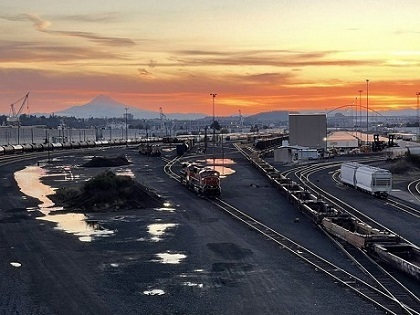
Chicago Illinois Midland 551
National Museum of Transportation
St. Louis
Photo of the Day
from my blog
#Train #Trains #Railroad #Transportation #Museum #Photography
2 Likes

Chicago Illinois Midland 551
National Museum of Transportation
St. Louis
Photo of the Day
from my blog
#Train #Trains #Railroad #Transportation #Museum #Photography
I don't have much luck with social networks, do I? I used to be mcv@nerdica.net, but nerdica seems to be quite thoroughly dead. Database is corrupt, and nothing can be recovered.
So that means I lost all my posts, comments, contacts, followers, and my place in the Fediverse. I'm trying to cobble things together, so if you recognise me, or even if you don't, please reach out and reconnect. I used to be on #Nerdica , #pluspora and I'm even a #googleplusrefugee.
So I'm not #newhere in the Fediverse, but I am new at this server. I run a #shadowrun #rpg #ttrpg campaign, occasionally post about a #boardgame I played, especially #18xx #railroad games, but also many others. I'm a #programmer , and I'm pretty sure I was also connected to a bunch of people in the #opensource #software world. I'm also interested in #tech, #science, and #computers in general.
I'm also occasionally interested in discussions of #politics, especially of the #leftwing #liberal #green and/or #libertariansocialism kind, though I'm not overly dogmatic on any of them. I #bicycle regularly, use #linux, and after all these social media servers I lost, I'm considering running my own #friendica server. I might even be nuts enough to try to write my own #fediverse software, which would probably end up much like Friendica (or #Diapora, or Google+), but not in PHP.
I'm probably forgetting a bunch of stuff, but I hope this post will help me reconstruct and reconnect what I lost.

#myphoto, #ViaAdrana, #Ederradweg
#Foto, #photo, #Eisenbahn, #Eisenbahngleise, #railroad, #railway, #Baum, #tree, #Natur, #nature, #Radtour, #biking, #Nordhessen, #Hessen, #fedibikes, @fedibikes_de group, @fedibikes group
the battle to liberate Shalamcheh was one of the bloodiest batles during the early days of Iraq invasion of Iran, the fact that Iran is building a railroad (no Iraq is not helping much there, despite their much talk). Because it is in Iran's interest to use the new connection to the rest of Iranian railroad system that is in really bad shape and need massive amount of money to modernize it, in order to be able to be part of the new Silk Road, to be ale to bypass the US sanctions and connect Russia and China to Arab countries without having Azerbaijan or Turkey involved.
Railroad defect detector database. There was a train derailment in East Palestine, Ohio, that released carcinogenic vinyl chloride. According to rumor the first people to know there was something wrong were "open source intelligence" (OSINT) people using software defined radio to listen in on defect detectors along the tracks. This website gives you a map of defect detectors and their frequencies. You can zoom in on your area and find the frequencies for defect detectors on rail tracks near you.
Railroad defect detectors do such things as measure the temperature of wheels and notice if wheel bearings are getting too hot, count train cars to make sure they're all there, and detect loose parts or equipment getting dragged on the track. It uses a VHF transmitter that is picked up by the driver up front, but anyone can pick them up. In my area (Denver), I can see 3 Union Pacific defect detectors and 1 BNSF defect detector.

The European Union has decided to spend 100s of billions of Euro to support modernizing the train networks across the continent and push for new routs as well as repair and modification of existing network.
One country has said no to getting such support, and it is the Swedish government. Their hate for trains and anything that benefits the fight against climate change is so strong that they have said no to receive up to 200 billion in EU funds in the coming years, creating 10s of thousands of jobs and a huge income for the government in shape of new taxes and benefits from the future high speed trains.
This is what right wing stupidity and CON-servatism doing. Their Trumpian hate of such progress is truly disgusting!
#Politics #Sweden #Railroad #HighSpeedTrains #Europe #GlobalWarming #Economy #svpol #Idiocracy

https://www.counterpunch.org/2022/12/05/us-railroad-workers-under-the-thumb/
'This past week both the administration and Congress have made a #railroad #strike #illegal by passing legislation to that effect. Railroad workers in the US have always been a target of government #strike-prevention. The RailwayLaborAct in 1926 set the pattern that was taken up for the rest of the US labor-force with Taft-Hartley in 1947 and all #anti-strike measures that followed.
The current 2022 railroad negotiations and government intervention is but the latest example of joint corporate-government intervention in labor negotiations designed to #prevent-workers-from-striking.' We are in a period when the US ruling elites are willing to attack any challenge to their hegemony and power #domestically, as well as internationally. The government’s recent intervention to #deny #railroad #workers #the-right-to-strike is but the latest and most visible expression of the elites’ #class-war-policy-at-home.'#under-the-thumb #unions #biden #govt #capitalism #us #administration #congress #railroad #strike #illegal #workers #strike-prevention #labor-force #taft-hartley #railroadlaboract #corporate-government #intervention #negotiations #ruling-elites #class-war
Quote below from https://thehill.com/homenews/senate/3643255-sanders-blocks-proposal-to-force-rail-unions-to-accept-labor-deal/
[Bernie] argued that railroad companies are making huge profits and should start treating their workers more fairly.
“The rail industry has seen huge profits in recent years and last year alone made a record-breaking $20 billion in profit,” Sanders said. “Last year, the CEO of CSX made over $20 million in total compensation, while the CEOs of Union Pacific and Norfolk Southern made over $14 million each in total compensation.”
By contrast, Sanders said that workers in the freight rail industry are “entitled to a grand total of zero sick days.”
Quotes below from https://www.axios.com/2022/09/13/with-rail-strike-looming-two-unions-are-holding-out
Working conditions — more than pay demands — are holding up the resolution of a years long labor dispute between the nation's largest freight rail companies and their unions.
The Brotherhood of Locomotive Engineers and Trainmen, and The SMART Transportation Division say in statements that they need paid sick leave and better policies around work hours, before they sign onto the deal, according to a recent statement.
There is no need for a #strike if #management agrees to reasonable #pay and #leave policies for #railroad #workers.